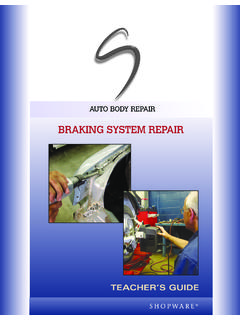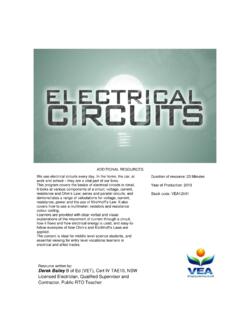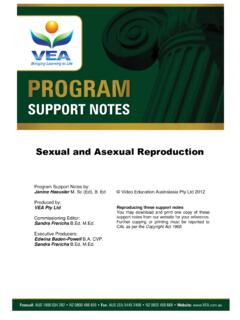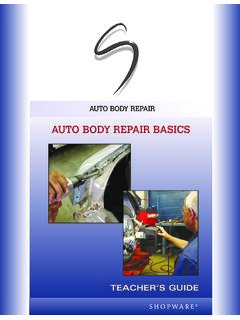Transcription of Proper Transfer Techniques For Healthcare Professionals
1 NATIONAL EDUCATIONAL VIDEO, 2011 1 Proper Transfer Techniques For Healthcare Professionals HCA 2711 PROGRAM GUIDE FOR HEALTH CARE ASSISTANTS NATIONAL EDUCATIONAL VIDEO, 2011 2 NATIONAL EDUCATIONAL VIDEO, OPTIMIZING MOBILITY IN OLDER ADULTS HCA 2711 PROGRAM DESCRIPTION This program focuses on the safe Transfer Techniques . It will demonstrate the use of good body mechanics by health care assistants and the correct use of assistive devices frequently used to promote mobility. Video running time: 30 minutes (2 contact hours). OBJECTIVES At the conclusion of this program, the participant will be able to: 1. Use appropriate Techniques for the promotion of mobility with older adults.
2 2. Observe for potential environmental safety issues. 3. Apply knowledge of assistive devices while caring for clients in a variety of settings. 4. Demonstrate the correct Transfer Techniques clients may need in both the home and long term care environment. 5. Review elements of good body mechanics when lifting and while assisting clients to move about. NATIONAL EDUCATIONAL VIDEO, 2011 3 NATIONAL EDUCATIONAL VIDEO, Proper Transfer Techniques For The Health Care Professional The Nursing Process The nursing process is a systematic method of problem solving. It is called a "process" because it is on-going. The steps of the nursing process are as follows: Assessment: This is the systematic and continuing collection of information from multiple sources.
3 Assessment begins when a nurse initially interviews a client and the client s significant others. A physical assessment of the client involves collecting information from a number of sources: laboratory data, direct observations, assessing the client s ability to carry out daily activities, noting signs observed by nursing personnel and symptoms reported by the client and any client responses to interventions. In long term care, resident assessment instruments are used to provide a comprehensive multi-disciplinary assessment. Problem Identification or Nursing Diagnosis: Assessment data leads to identifying client strengths and client problems. These may be actual problems the client currently experiences, or potential problems that may occur with that client in the future.
4 Problems are stated and an indication of influencing factor or cause is included in the statement, when nursing diagnosis statements are used. Planning: The next step the nurse will complete is planning, with input from other care providers. It will focus on client goals (or outcomes). For each problem, a measurable, specific goal is identified. The plan includes nursing actions, based on of nursing theory, nursing science, other sciences, research findings and experience through practice. The beliefs and values of the nursing profession, in combination with the values of the client, are taken into account in the establishment of the nursing care plan. Implementation: Carrying out the nursing care plan. Evaluation: This is the component of the process where client goals and related outcome are evaluated to determine if they were met.
5 The nursing care plan is revised accordingly. Evaluation may also identify additional resources that are needed for the client or the health care provider while continuing to utilize the nursing care plan. Professional Nursing Roles: As the nurse carries out the nursing process, the nurse enacts a variety of professional roles. These are: clinician teacher client advocate leader These roles may overlap. In the clinician role, the nurse may provide direct "hands on" care, or may assess a client's needs and direct others to provide services to meet those needs. The nurse may conduct patient and family teaching in a teaching role. The nurse may also teach other health Professionals when a multidisciplinary team addresses the client's needs.
6 The nurse is a client advocate when collaborating with the client, finding resources for the client, and acting on behalf of the client. The nurse is a leader when planning and assigning the care of a client to others, maintaining overall responsibility and accountability for that care, assisting other members of the health care team to set and meet goals or when providing resources to other health care providers. NATIONAL EDUCATIONAL VIDEO, 2011 4 NATIONAL EDUCATIONAL VIDEO, Proper Transfer Techniques For The Health Care Professional HCA 2711 GLOSSARY OF KEY TERMS Active Exercises: Muscular action of a joint as a result of voluntary effort on the part of the client without help from another person.
7 Assistive Devices: Equipment used to help clients who have limitations with mobility to move about more readily. Body Mechanics: Physiology of muscular actions and functions to promote good body posture and prevent injuries. Center of Gravity: The midpoint or center of the body s weight. Gait Belt: A belt used to support a client at their center of gravity and to assist a caregiver in transferring that individual from one location to another. Impaired Physical An individual with limitations in his/her ability to move about Mobility: independently. Mechanical Lift: A device that assists in transferring clients from bed to a chair, for example. It is generally used when the client cannot be moved safely by one or two persons readily.
8 Posture: The position of body with respect to the surrounding space. Pivot Transfer : The movement of one person from one site to another, such as from a bed to a chair, using a motion where the health care assistant s center of gravity is turned, while the person stands with weight on the strong side and carefully lowers to a sitting position Walker: A light-weight movable apparatus with four legs, approximately waist high, made of metal tubing and used by the client to assist in walking. NATIONAL EDUCATIONAL VIDEO, 2011 5 NATIONAL EDUCATIONAL VIDEO, Proper Transfer Techniques For The Health Care Professional HCA 2711 PRE TEST Circle T if the following statements are true. Circle F if the statements are false.
9 T F 1. Only a physical therapist can perform client transfers from bed to chair. T F 2. Attention to good body mechanics is essential for all caregivers. T F 3. Chair alarms are an alternative to the use of restraints. T F 4. Back injuries are often the result of health care providers not using good body mechanics. T F 5. Clients may suffer serious injury if their arms are pulled in an effort to move them. T F 6. For the more dependent client, the health care assistant should use a slide board, disc or mechanical lifting device. T F 7. To perform a client Transfer from their bed to their chair, remember to use a gait belt around the client s waist. T F 8. When lifting a box, you should keep the box away from your center of gravity.
10 T F 9. Brakes are found on beds, wheelchairs, and most shower chairs. T F 10. Before transferring a client from bed to chair or toilet, the health care assistant should explain the procedure to the client. NATIONAL EDUCATIONAL VIDEO, 2011 6 NATIONAL EDUCATIONAL VIDEO, Proper Transfer Techniques For The Health Care Professional HCA 2711 DISCUSSION QUESTIONS 1. What can you do to prevent back injuries? 2. What are the most important elements of good body mechanics? 3. Describe three important features of using each of the following assistive devices: a. wheelchairs b. walkers c. mechanical lifts 4. Your client weighs 180 pounds and has left-sided weakness following a stroke.








